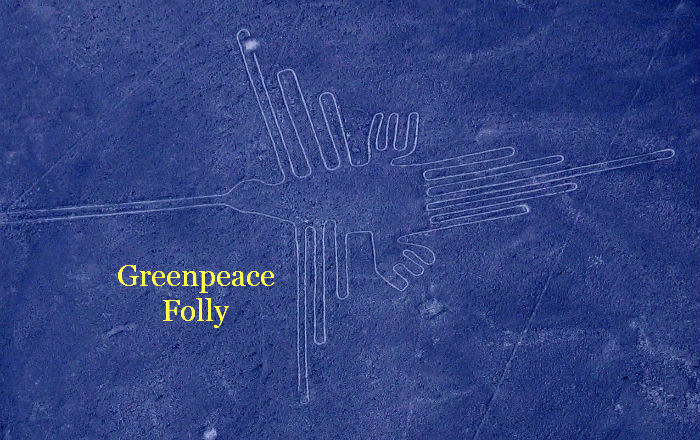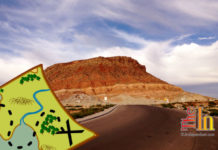 Written by Greta Hyland
Written by Greta HylandWe have all had moments of stupidity, doing things we later looked back on and wondered, What was I thinking? They are usually moments that lack wisdom, foresight, or any hint that thinking was used at all. This is certainly the case with Greenpeace in the aftermath of the recent desecration of the ancient Nazca Lines etched into the desert floor on Peru’s coast between 2,000 and 1,500 years ago. In an attempt to send a political message that would catch the eye of delegates flying overhead on their way to climate talks, Greenpeace instead caught the ire of Peruvians as well as derision from the global community.
If you are unaware of what Greenpeace did, they laid out glaring yellow letters on the ancient site, urging respect for the environment by proclaiming, “Time for Change! The Future is Renewable.” Not only that, they walked out to the site in single file in a flimsy attempt to mitigate their presence, and instead left a trail of footprints and outlines of the letters captured in photographs by drones flying overhead.
Speaking to the Associated Press, Deputy Culture Minister of Peru, Luis Jaime Castillo said,“It’s a true slap in the face at everything Peruvians consider sacred.” He explained that the delicate drawings are absolutely fragile and that due to the topography of black rocks on a white background, when you walk there, the footprint is going to last hundreds or thousands of years. He went on to explain that where the group put the lettering was on the most “visible and recognized line.”
Whether Greenpeace likes it or not, they have just included themselves in the ranks of right-wing conservatives who drove ATVs through ancient Indian ruins in Recapture Canyon; with Casey Nocket, the would-be artist who doodled all over rocks across our National Parks and landscapes; and yes, even with abortion clinic bombers. Stay with me for a minute, I will revisit that in a moment while you digest it. What all of these people have in common is a lack of respect for other views, people, and cultures. Their actions betray homogeneity on a small scale.
I don’t want to be too hard on Greenpeace. I am sure their enthusiasm and good intentions to catch the attention of climate talk delegates for their cause gave them a blind spot that common sense might have steered them clear of. But good intentions or not, we all know what the road to hell is paved with. Their intentions and stupid act, however, aren’t the worst of it. What they and the other aforementioned groups reveal, whether intentionally or not, is the subtle and malignant mentality prevalent in our society of a complete lack of respect or regard for native people and their cultures.
How can I justify this statement? Because it happens all the time and by dominant social groups. Whether it is riding ATVs through ancient burial sites, scribbling on petroglyphs, or knocking over thousand-year-old hoodoos, it’s the level of disrespect that is blatantly obvious. I’m fairly certain that if similar acts were routinely done to the dominant social groups and their sacred places, they would be just as upset and perhaps might learn to see things differently.
But glaringly evident is the fact that those who are doing these sorts of things highlight a prevalent bias and dismissal of indigenous people and their cultures across the board: liberal or conservative, religious or non-religious. The fact that it didn’t occur to any of them that their act might not go over well is the most egregious aspect of the whole affair. Group think comes to mind. This is the danger any group faces if they do not have different eyes looking at their decisions and checking their worldview.
If they’d had that, perhaps Greenpeace wouldn’t have done this to begin with, but definitely would have given the heartfelt apology necessary from the outset rather than being sorry that the Peruvian people were upset.
See, the inconvenient aspect of pushing a moral imperative is that people look closely at you to see if you are living by your own code. Environmentalists, like religious people, have a moral mandate. When an environmental group disrespects or uses another culture to push their own agenda, they undermine their own cause; but even worse than that, they give everyone who supports that group a bad name. Like Christians who blow up abortions clinics in the name of Jesus and hurt all Christians as a result; Greenpeace hurt all environmentalists with their desecration of this ancient site.
Will Peruvians get beyond this? Sure, but what choice do they have? Will Greenpeace and environmentalists move on? Yes, though deservedly scraped and bruised, and with criminal charges being brought against them, there will be more scrapes and bruises to come. But it doesn’t change the fact that their reputation has been marred and that this stunt will be remembered with far reaching repercussions for a long time. The only real light at the end of the tunnel is that perhaps their footprints and letter outlines on the ancient site will act as a reminder of what not to do. I truly hope the attention they drew to themselves while trying to influence the climate talks doesn’t influence the climate discussions or worsen attitudes already opposed to progress on that front. What a travesty.
To see photos and for the in-depth story click here: Indian Country
 Greta Hyland has a Masters degree in Environmental Policy & Management and has worked for the BLM and the NPS as well as for non-profit organizations. She is a regular contributor to the Utah Adventure Journal and is the Copy Editor at the Independent. She writes regularly on her blog about environmental policy issues affecting the southwest, as well as personal narratives about outdoor recreation and simple living. Her blog can be found at www.thesouthwestjournal.wordpress.com A Utah native, Greta is a consummate desert rat and loves exploring the southwest. She can be reached at [email protected].
Greta Hyland has a Masters degree in Environmental Policy & Management and has worked for the BLM and the NPS as well as for non-profit organizations. She is a regular contributor to the Utah Adventure Journal and is the Copy Editor at the Independent. She writes regularly on her blog about environmental policy issues affecting the southwest, as well as personal narratives about outdoor recreation and simple living. Her blog can be found at www.thesouthwestjournal.wordpress.com A Utah native, Greta is a consummate desert rat and loves exploring the southwest. She can be reached at [email protected].




